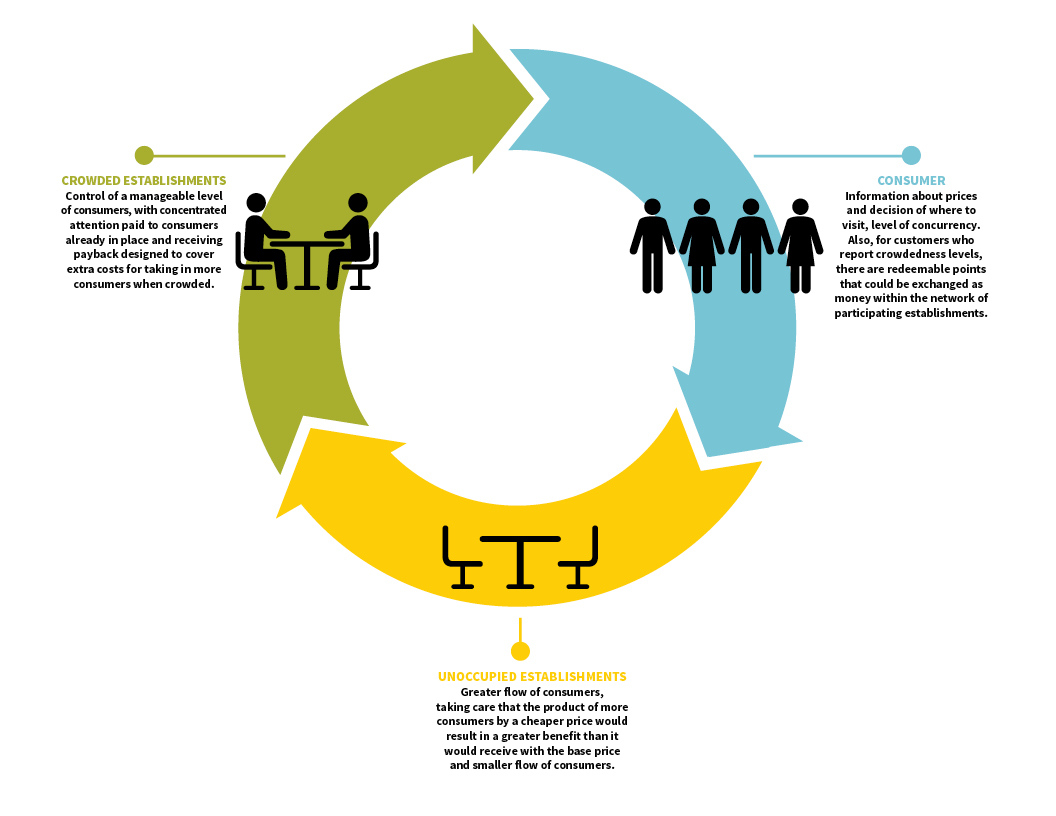Greener: A Resilient Recovery Platform for Tourism
How to make tourism an agent of environmental development and sustainability
May 2023Spanish Version
Portuguese Version
Mass tourism is an economic force that created environmental havoc and was brought to an immediate halt by the COVID-19 pandemic. COVID-19 and its global spread have affected the tourism sector drastically to the point of changing the form of conducting business. As individuals entered mandatory seclusion during the pandemic, the industry crashed. International tourism decreased 22% in Q1 and 61% in the first half of 2020 compared to 2019.1 However, as nations reopened their borders, tourism has sluggishly begun to emerge again, leaving the door open for new ways of engaging in the business. Instead of mass tourism, the pandemic gives leeway to partake in sustainability, avoiding the risk of exploiting the sector’s greatest assets.
This article proposes the creation of a platform of voluntary binding commitments that would regulate population density and could provoke significant change in these tourist hotspots. It considers the implications of requesting tourism-related companies that are established in tourist poles to alleviate ecosystems’ burdens by spreading the population across different touristic sites.
OUTLINE OF THE PROBLEM
The literature outlines that tourism holds three major environmental issues: natural resource usage, behavioral considerations and pollution.2 Therefore, the depletion of natural resources due to a disproportionate increase in consumption and a disregard for consumers’ environmental consciousness led to adverse environmental effects. Indeed, the problem is that tourism can be, and has been, a destructive force for ecosystems. Therefore, there is a need for a resilient tourism industry that avoids masses of people and reduces the user density and consequent exploitation of resources.
It is necessary to spread out people across destinations, preventing accumulation that would lead to the overconsumption of natural resources and preventing a zone from reaching a sustainable plateau regarding the ecosystem’s regeneration capabilities and its lure as a tourism spot. Instead of intensive touristic activity that incites the destruction of ecosystems, the shambled industry allows us to remake it as more eco-friendly and with a healthy environment as a forefront concern.
This article considers that for colossal problems with no evident solutions, it is necessary to implement disruptive ideas that may suggest a change in the way regulation, economy and many other aspects of the dynamics in our world work. For this, the following solution is proposed.
PROPOSED SOLUTION
This proposal seeks to make tourism an agent of environmental development and sustainability. To achieve this, it considers creating a platform where a wide range of touristic establishments would be registered, which would include restaurants, commercial points, bars and other service spots. The platform would receive information about the number of people within these zones and assign prices on their goods and services based on this number. The prices would fluctuate proportionally to the number of people within each zone. In other words, they would increase as the number of people within the zone increases, and decrease accordingly. In this way, the tourist would be incentivized to visit the less-crowded zones. Under the proposed solution, tourism density would spread out, allowing ecosystems to rebalance more sustainably.
The platform would be completely voluntary. In this sense, the establishments must register and accept the terms and conditions of the platform. Through these, they will agree to be monitored and to establish quoted prices. The nonbinding agreement between the establishment, consumers and the platform would allow for a constant flow of information. It would simultaneously benefit less-occupied establishments by boosting the number of visits to that location and more-occupied establishments by allocating a percentage of the benefit received by the emptier establishment as an incentive. Also, consumers would get a benefit for validating the information collected.
Currently, some platforms measure the population density of a specific location for mobility or user information. For example, Google uses “aggregated and anonymous data from users who have opted into Google Location History.” Waze users “share real-time information that translates into traffic conditions and road structure,” as well as have the freedom to report any mishaps on the road and, therefore, enhance the application’s usage. The article proposes incorporating these algorithms to geographically reference the concurrency of establishments with the location of electronic devices that consumers use and through validation of specific details in the platform by the users who are at these locations.
The platform would also maintain alerts about the state of any ecosystem, functioning simultaneously as an awareness tool. These alerts would indicate the capacity of the specific ecosystem, its deterioration state and risks that arise in very crowded places. More virgin areas could sustain more allure from tourists with ecotourism in mind. Due to the conjunction presented by the pandemic, individuals have become more aware of the impacts of human density concerning nature. Thus, the platform would use this concern as a catalyst for further awareness.
Furthermore, through the platform, consumers could book or rate the services or goods and share their experiences with photos or videos. Partner establishments could also advertise their commerce and list information regarding their services, goods, infrastructure and other related information. The platform would generate meaningful data to analyze and interpret consumer behavior concerning these industries and help the establishments efficiently manage their supply. Additionally, it would serve as a tool for the public and private sectors’ decision-making processes. For instance, government entities could determine which zones need special attention regarding business regulation or conditioning deteriorated areas. The most crucial part is that this information would be readily available under a premise of solidarity and collective effort toward the planet’s well-being.
For the sake of having a decentralized tool, we propose the platform be based on a technology such as a blockchain, so the information received and shared with users could be safeguarded from embezzlement or misrepresentation.
FINANCIAL SUSTAINABILITY
The platform assumes that participating partner establishments set their prices beforehand. The platform would encourage consumers to report the concurrency details of establishments and validate the statistics generated automatically by geolocation. As a result, the consumers would gain points as a reward mechanism that could be redeemed later in the network of participating establishments. Consumers willing to visit establishments could see this information on the platform. According to the concurrency level, they would be informed of the price recharge or discount that a determined establishment is offering at the moment, inciting visits to the less concurred.
To stimulate harmonious participation among establishments, the platform would pay back a marginal proportion of the extra benefit that the less-concurred place receives for the additional flow of consumers to the places that would have received them at first. This payback would be determined to cover at least the marginal cost generated to the concurred place to receive the potential customer when crowded. This way, all parties would benefit financially, as shown in the following chart, resulting in a better position:

This model could be escalated to any system of providers and consumers of goods and services in any geographic area. The primary objective would be to reduce the footprint of economic activities. Moreover, the idea could be extrapolated to the public sector, allowing state institutions to shift from the platform’s endeavor nature to more bidding commitments. As a public-private alliance or fiscal policy, the state’s intervention could lead to the necessary firm obligations to confront the imminent damage to Earth.
Since the platform would be administrated through blockchain technology, an initial round of capital might be needed. But further administration and escalation would result simply in terms of cost and implementation. After the initial launch, the platform would be relatively self-sustaining.
This project seeks to measure success with indicators that inform sustainable development. The environmental dimension would be evaluated by the indicator of the ecological footprint of the targeted zones, correlated to the platform’s usage level and the information it captures from consumers, capturing the social aspect of this project. The ecological footprint measures the total land area that is required to maintain the food, water, energy and waste-disposal demands per person, product or city.
CONCLUSION
Ideas for greener solutions and a pathway for a resilient planet could flourish in sectors such as tourism. The means need to be solved, but the need for diverse stakeholders to get on board with these ideas to produce timely results within the framework of the 2030 agenda is clear. Not only is financial support needed, but a fertile ground for regulation and markets to develop and materialize such ideas is necessary as well. A platform like the one proposed in this article could be the building block of a tourism revolution based on actuarial principles.
Statements of fact and opinions expressed herein are those of the individual authors and are not necessarily those of the Society of Actuaries or the respective authors’ employers.
References:
- 1. Sbai, A. How COVID-19 Impacted Travel & Tourism Industry Globally. September 28, 202 (accessed March 31, 2021). ↩
- 2. Holden, A. 2008. Environment and Tourism. Environment and Tourism: Routledge. ↩
Copyright © 2023 by the Society of Actuaries, Chicago, Illinois.

